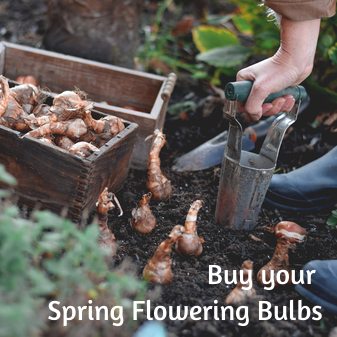Our September gardening tips and jobs mark the start of meteorological autumn; the soil is still warm, and perhaps a little more moist, making it a good time to plant some Spring flowering bulbs. Day lengths start to markedly shorten this month, so growth rates slow, and time in the garden becomes a little more limited.
However, it’s a great time to take stock of how your garden has been over Spring and Summer, and so to start thinking about next year’s displays – you might want to add new shrubs & hardy perrenials, plan which plants need to move, or collect seed for sowing now or in Spring.

Plants on sale now and looking good at Earlswood in September:
- Heathers.
- Cyclamen.
- Pansies and violas.
- Spring Flowering Bulbs – you’ll find these inside our shop; best choice and range available in September.
- Christmas Seed Potatoes – grab them while you can – limited availability.
Top gardening tips and jobs for September:
Divide herbaceous perennials.
Not only does this multiply your plants, but it also encourages vigorous plants that do well year after year. Plant divided plants as soon as possible and water them in well. You can either replant them in the same position or move them to a new part of the garden. It’s a great opportunity to mix in some compost or other soil improver before replanting.
Although moving herbaceous perennials can also be done in Spring, it’s easier to see now, while there is still some foliage, where they are growing and how they might look in their new position.
Pick autumn raspberries.
Collect and sow seed from perennials and hardy annuals.
If storing seed, ensure they are dry, and using small paper envelopes works best. Don’t use plastic bags. Then store in a airtight container and keep them in your fridge or another cool dry place.
Dig up remaining potatoes before slug damage spoils them.
Net ponds before leaf fall gets underway.
We sell netting by the metre or pre-packed.
Divide water lillies.
Water lillies in aquatic baskets can be rejuvenated by dividing their roots and re-planting them. Be sure to use low-nutrient aquatic compost as high nutrients can cause excessive algae growth in your pond. When you’ve done, place the baskets back into shallow water until the plants are producing new leaves, then gradually increase the depth.
We sell aquatic plant baskets and compost in our plant area.
Keep up with watering of new plants, using rain or grey water if possible.
New plants, or plants that have been moved will need watering until reliable and regular autumn rains set in.
Start to reduce the frequency of houseplant watering and feeding.
As the days shorten and temperatures cool, housplants will need less watering and feeding. Wherever possible check the compost by sticking a finger a couple of cms down into the compost surface to decide if watering is needed. Over-watering is often the cause of houseplant death, particularly in orchids.
Clean out cold frames and greenhouses so that they are ready for use in the autumn.
As the light levels and day length get less, cleaning your greenhouse glass and removing any shading will ensure you get maximum light. Use warm soapy water, or we sell a greenhouse cleaning spray.
Cover leafy vegetable crops with bird-proof netting.
Plant spring flowering bulbs.
You’ll find a good choice inside our shop. Narcissi and daffodils make better plants if planted really early because they start to form new roots straight away. Tulips can be bought now but are best planted a little later in November or December – if planted too early they can be affected by fungal diseases.
Plant winter lettuce.
There are several varieties of salad crops which are suited to growing throughout the winter when light levels are lower. “Winter Density” is a good cos type lettuce that i’ve grown successfully. You may need to use a cloche or grow in the greenhouse in exposed sights as strong island winds can damage your crop.